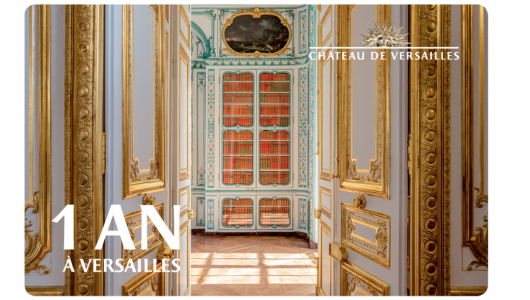From Abel Gance to Sofia Coppola, from Sacha Guitry to Pierre Schoeller... Since 1896 and the first mention of a film shot in the gardens of Versailles, the Estate of Versailles has never ceased to open its doors to French and international cinema.
Versailles and Cinema
Films in the Palace of Versailles
With almost 240 films shot in the Estate between 1896 and 2024, the Palace’s filmography is far from negligible.
Iconic films in the history of cinema, well-known directors and famous actors have all contributed to the Palace’s reputation. Examples include films by Max Lyon and Henri Lavedan in the early 20th century; Napoleon by Abel Gance; The Queen’s Necklace by Marcel L’Herbier; Madame de... by Max Ophüls; Le Mariage de Chiffon by Claude Autant-Lara, which was one of the films which made him famous; films by Sacha Guitry including the legendary Royal Affairs in Versailles; The 4 Horsemen of the Apocalypse by Vincente Minelli and Molière by Ariane Mnouchkine, not to mention films by Philippe de Broca, Ettore Scola and Stephen Frears.
Having been a source of interest to filmmakers since the beginning of cinematographic production, Versailles has witnessed every development in the art, from the first motion pictures as developed by the Lumière brothers to increasingly strong involvement in television productions. Among others, in 1929 the Estate was used as the set for the film The Queen’s Necklace by Gaston Ravel, which was the first French film with a soundtrack.
Furthermore, the films shot in Versailles cover a hugely diverse range of genres. Surprisingly, historical films account for only a third. Both films d’auteurs and mainstream movies have remained a constant source of fame for Versailles. With four biographic documentaries and four films on the affair of the diamond necklace, the life of Marie-Antoinette has uncontestably been the most popular subject in this category. Other film topics include Napoleon (three films), Casanova (two films), Mme Du Barry, the poison affair and the French Revolution.
The range of genres among the contemporary films is incredibly diverse, including comedy-drama, comedy, fantasy, romance, war and espionage films. In some productions the Palace of Versailles is included in the story for what it represents today, i.e. a piece of heritage and a monument that evokes the monarchy, such as in Le Tatoué in 1968 when Jean Gabin, playing alongside Louis de Funès, said “He has come to admire the residence of the kings who built France over 1000 years”. It may also, however, be used as a setting for other scenes, in which case more neutral sites that are not easily recognisable are filmed.
A list of films shot in Versailles between 1896 and 2024
Cinema & Versailles in the 20th century
A lot of movies were filmed at the Palace of Versailles during the 20th century. From Sacha Guitry and his famous Royal Affairs in Versailles to James Ivory and Jefferson in Paris.
Royal Affairs in Versailles 1953
This film, whose French title is Si Versailles m’était conté, retraces the history of the Palace of Versailles from its origins until the French Revolution. It was produced in the aftermath of WWII, from which France was struggling to recover. In making it Sacha Guitry wanted to silence certain opponents who were criticising him for his ambiguous stance towards the German occupiers during the war. The film, which was proposed to Guitry, was also designed to reunite the French people around a historical panorama.
Once the proposition had been accepted the project progressed swiftly. The screenplay was written in spring 1953, filming was between 6 July and 6 September, the film was released in France the following year. The casting matched the political aims behind the project, with Claudette Colbert as Mme de Montespan, the mistress of an aging Louis XIV played by Sacha Guitry. Jean Marais played the role of Louis XV, with Micheline Presle as Mme de Pompadour. Other well-known figures also featured in the film, including Gérard Philippe as d’Artagnan and Edith Piaf as a revolutionary woman singing Ça ira at the Palace gates…
Although certain historians criticised the inaccuracies running through the film, its success among the public paved the way for a period of cinematographic popularity for the Palace of Versailles, from Jean Delannoy’s Marie-Antoinette played by Michèle Morgan in 1955 to the likes of Kirsten Dunst in the same role with Sofia Coppola as Director more than half a century later. A large number of film actors and actresses have trodden the Palace’s alleys, galleries and halls.
Cinema & Versailles in the 21th century
From Gérard Corbiau's The King Is Dancing to Jean-Marc Moutout's Victor Hugo, Ennemi d'Etat, the Palace of Versailles has been the setting of numerous films since the early 2000s...

The official Palace of Versailles app
The free application of the Palace offers audio tours to accompany your visit to the Estate (Palace, Gardens, Trianon Estate, etc.) as well as an interactive map.
More information
Are you a regular visitor?
The best of Versailles for subscribers! For a whole year, benefit from numerous advantages thanks to the SOLO or DUO cards, and unlimited ticket access from only 65€.
Choose your subscription



